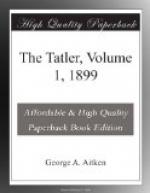Something must be said of the events of 1710, which led to the discontinuance of the Tatler. The trial of Dr. Sacheverell in March was followed by the fall of the Whigs in the autumn; and in October Steele lost his post of Gazetteer. Swift says it was “for writing a Tatler some months ago, against Mr. Harley, who gave him the post at first.” There was a growing coldness between Swift and his old friends, and on the 3rd of November Swift wrote, “We have scurvy Tatlers of late, so pray do not suspect me.” On the preceding day Swift’s first paper in the Tory Examiner had been published. He still met Steele from time to time, and he says that he interceded for him with Harley, but was frustrated by Addison. However this may be, it is certain that Harley saw Steele, and that as the result of their interview Steele retained his post as Commissioner of the Stamp Office, and brought the Tatler to a close on January 2, 1711, without consulting Addison. “To say the truth, it was time,” says Swift; “for he grew cruel dull and dry.” It is true that there is a falling off towards the close of the Tatler, but that it was not want of matter that brought about the abandonment of the paper is proved by the commencement only two months later of the Spectator. Steele himself said that on many accounts it had become an irksome task to personate Mr. Bickerstaff any longer; he had in some places touched upon matters concerning Church and State, and he could not be cold enough to conceal his opinions. Gay tells us, in “The Present State of Wit,” that the town being generally of opinion that Steele was quite spent as regards matter, was the more surprised when the Spectator appeared; people were therefore driven to accept the alternative view that the Tatler was laid down “as a sort of submission to, or composition with, the Government for some past offences.”
Excellent testimony to the immediate popularity of the Tatler is furnished by the fact that its successive numbers were reprinted in Dublin and in Edinburgh. At least sixty-nine numbers of the Dublin issue, in quarto, were printed. The Scottish re-issue was a folio sheet, commenced about February 1710, and continued until the close of the paper. The date of each number of the Edinburgh paper—“printed




